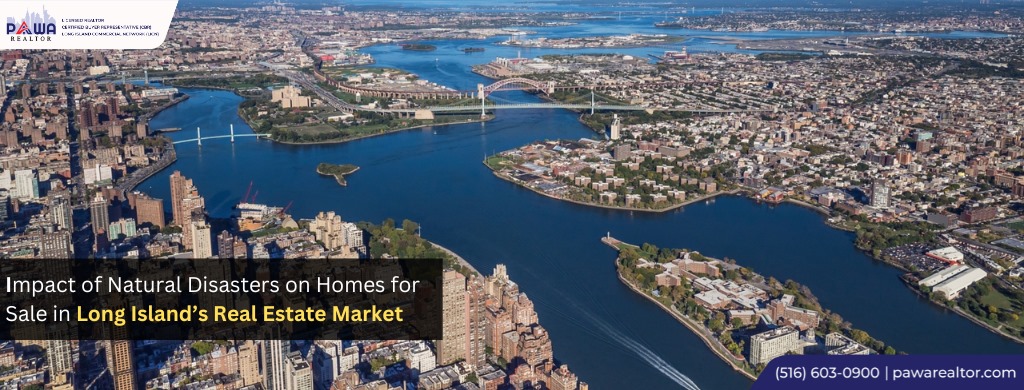When natural disasters hit any area whether it’s an earthquake or a hurricane or flood, it always leaves a devastating trail of chaos and unrest. Most businesses come to a standstill as collective effort is directed towards recovering and healing. Among them, the real estate market is affected the most since both buying and selling real estate comes to a halt. Homes for sale in Long Island get hugely impacted.
Moving houses become nearly impossible, even for a trusted realtor in Long Island. Regardless of the geographical location, the aftermath of any natural disasters is almost crippling for real estate businesses. However, with experience and understanding the impacts of natural disasters, one can safeguard themselves to some extent.
Understanding the Repercussions of Natural Disasters For the Real Estate Business
Long Island has a history of tropical cyclones landing on its shores and hurricane landfalls sweeping up entire streets. The damages are long-lasting and unpredictable. In addition the global sea level rise adds extra uncertainty for everyone residing in the coastal regions. Long Island, being surrounded by water, has to leave a major portion of land out of the market. The increasing intensity of the hurricane season every year is not making things any easier for the housing industry.
Let us understand in depth the different aspects of how the real estate market is affected in the aftermath of natural disasters.
Physical Damage to Properties and Infrastructure
What realtors do – they provide homes for sale in Long Island. Sadly,physical property damage is the most obvious and direct effect of natural catastrophes. There might be serious damage to residential and commercial properties as well as public infrastructure. Long Island, having many seaside residences, is frequently worried by flooding and hurricane-related wind damage. This damage can cause properties to become uninhabitable for extended periods of time in addition to expensive repairs.
Critical infrastructure, including utilities, roads, and bridges, can also be seriously impacted in addition to residential dwellings. Recovery efforts become more difficult and costly as a result of the interruption of vital utilities including transportation, water, and electricity. Property values may drop as a result of the damage’s long-term effects, particularly in places that experience frequent natural disasters.
Impact on the Local Economy and Property Prices
Property values in the impacted areas frequently decrease as a result of natural catastrophes. What were earlier affordable houses for sale in Long Island are no longer sustainable. The market value of properties on Long Island that are vulnerable to hurricane damage or floods decline significantly if buyers become apprehensive about the hazards involved. This leads to investors withdrawing from supporting mortgages as they become apprehensive of greater danger and the possibility of future calamities.
There is more to the economic impact than just property values. Local companies may sustain significant losses, particularly those reliant on tourism and hospitality. The economy as a whole may suffer from the decline in consumer spending as well as the expense of reconstruction and repairs. In smaller towns where the local financial health is greatly influenced by the real estate market, this economic downturn may be especially noticeable.
Increased Insurance Claims Driving Up Premiums
There is a significant rise in insurance claims when owners of property look for reimbursement for the harm they have suffered. Insurance businesses may experience delays in reimbursements or, in the worst situations, insolvency as a result of the increase in claims. The extra load on the insurance company drives up the cost of premiums. The associated risk level also contributes to rising premiums. Property owners may be discouraged from making future investments and developments in disaster-prone locations by the financial strain of increased rates and possible challenges in obtaining sufficient insurance coverage.
Population Migration
Population migration may result from natural disasters when people move in search of more secure and safe living conditions. This phenomenon is most noticeable on Long Island in places that are frequently struck by strong storms or flooding. There may be a decrease in population in some places if homeowners decide to move to less vulnerable locations and sell their homes at a loss. The reduced demand further decreases property values, greatly affecting homes for sale in Long Island. Entire communities’ economy is affected as a cascading effect.
Decreased Supply of Housing
The physical damage caused by natural disasters, coupled with population migration, can lead to a decreased supply of housing in certain areas. This decreased supply can create a more competitive market for the remaining properties, driving up prices in safer areas while leaving disaster-prone regions with an excess of unsellable or undervalued homes. Sadly, affordable houses for sale in Long Island become restricted to the dangerous regions.
Final Thoughts
The real estate market on Long Island is significantly and permanently impacted by natural catastrophes. These occurrences influence the housing environment of the region in a variety of intricate ways, ranging from direct physical damage to buildings and infrastructure to indirect economic and social repercussions. Property owners, investors, and legislators must comprehend these effects as they negotiate the difficulties of relocating to and making investments in disaster-prone areas.

